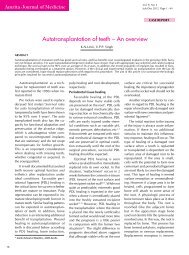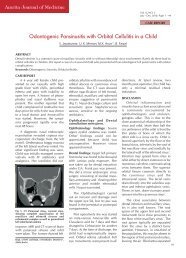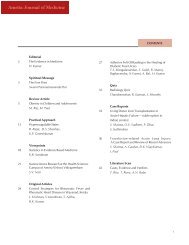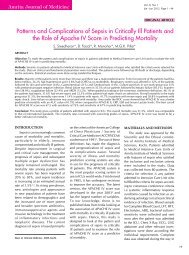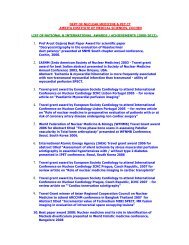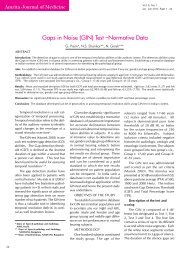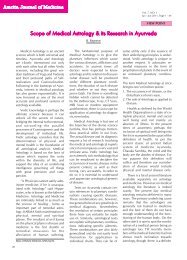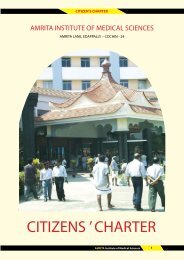Journal of Medicine Vol 4 - Amrita Institute of Medical Sciences and ...
Journal of Medicine Vol 4 - Amrita Institute of Medical Sciences and ...
Journal of Medicine Vol 4 - Amrita Institute of Medical Sciences and ...
You also want an ePaper? Increase the reach of your titles
YUMPU automatically turns print PDFs into web optimized ePapers that Google loves.
<strong>Amrita</strong> <strong>Journal</strong> <strong>of</strong> <strong>Medicine</strong><br />
Analysis <strong>of</strong> GSTM1 <strong>and</strong> CYP1A1 Genes in<br />
Tropical Chronic Pancreatitis: A Pilot Study<br />
ORIGINAL ARTICLE<br />
A.G. Unnikrishnan*, S. Ramach<strong>and</strong>ran**, M.R. Pillai***, H. Kumar*, P. Nair****, R.V. Jayakumar*,<br />
U. Guruprasad*, R. N<strong>and</strong>akumar****, T. Joseph**, I. Hariharan**, V. Balakrishnan****<br />
ABSTRACT<br />
Background/Objective The etiopathogenesis <strong>of</strong> tropical chronic pancreatitis (TCP) remains unknown. Oxidative stress <strong>and</strong> exposure to<br />
environmental toxins (xenobiotics) have been proposed as risk modifiers. The objective was to study the prevalence <strong>of</strong> selected abnormalities<br />
in the xenobiotic metabolizing genes in subjects with TCP.<br />
METHODS<br />
Twenty-one patients attending the Pancreas Clinic at our center were studied <strong>and</strong> the results <strong>of</strong> gene analysis were compared with a control<br />
group <strong>of</strong> 400 healthy volunteers. The outcome studied was the prevalence <strong>of</strong> deletions <strong>and</strong> mutations in the xenobiotic-metabolizing genes<br />
GSTM1 <strong>and</strong> CYPA1 <strong>and</strong> the DNA repair gene XRCC1 in subjects with TCP.<br />
RESULTS<br />
Our results show that 9.5% <strong>of</strong> subjects with TCP had deletions <strong>of</strong> GSTM1 <strong>and</strong> 33% had polymorphisms <strong>of</strong> CYP1A1. In the control group<br />
(n=400) the prevalence <strong>of</strong> these polymorphisms were 28% <strong>and</strong> 16% respectively. Compared with controls, polymorphisms <strong>of</strong> CYP1A1 were<br />
commoner in subjects with TCP, though this was not statistically significant (p= 0.064). The prevalence <strong>of</strong> GSTM1 polymorphisms was higher<br />
in the control group, but this too was not statistically significant (p= 0.077).<br />
CONCLUSIONS<br />
These results <strong>of</strong> this small pilot study do not imply that a genetic susceptibility to environmental disruptors could be an important factor in<br />
the pathogenesis <strong>of</strong> TCP. Larger studies are needed to assess the links between these genes <strong>and</strong> TCP, especially considering that both are<br />
associated with a higher risk <strong>of</strong> pancreatic cancer.<br />
Keywords<br />
Endocrine disruption, pancreatic diabetes, oxidative stress, xenobiotic, chronic pancreatitis, pancreatic cancer<br />
ACKNOWLEDGEMENT:<br />
We thank Surya Ramach<strong>and</strong>ran <strong>and</strong> Indhu Hariharan for help in carrying out the analysis.<br />
INTRODUCTION<br />
The etiopathogenesis <strong>of</strong> Tropical<br />
chronic pancreatitis (TCP) has been a<br />
mystery 1,2 . Malnutrition <strong>and</strong> cassava<br />
intake had been the preferred hypotheses<br />
earlier, but these hypotheses have<br />
now been strongly questioned 3,4 . In<br />
recent times, genetic factors have led<br />
to a paradigm shift in the underst<strong>and</strong>ing<br />
<strong>of</strong> the illness 5 , TCP is increasingly<br />
being recognized as a heterogeneous<br />
disease with multiple risk factors 3,5 .<br />
*Dept. <strong>of</strong> Endocrinology <strong>and</strong> Diabetes, AIMS, Kochi.<br />
**Regional Cancer Center, Triv<strong>and</strong>rum.<br />
***Rajiv G<strong>and</strong>hi Center for Biotechnoly,<br />
Triv<strong>and</strong>rum.<br />
****Dept. <strong>of</strong> Gastroenterolgy, AIMS, Kochi.<br />
These risk factors could either be an<br />
extrinsic toxin, or an intrinsic abnormality<br />
increasing the subjects’<br />
vulnerability to extrinsic factors.<br />
Xenobiotics (environmental toxins<br />
like. cigarette smoke <strong>and</strong> occupational<br />
chemicals) have been proposed as extrinsic<br />
factors involved in pancr<br />
eatitis 6 . Xenobiotic compounds include<br />
solvents, fuels, phenols,<br />
polyaromatic hydrocarbons, herbicides,<br />
<strong>and</strong> halogenated alkanes.<br />
However their mere presence in the<br />
atmosphere is not sufficient, <strong>and</strong> increased<br />
susceptibility to these<br />
xenobiotics, it has been postulated,<br />
could be conferred by micronutrient<br />
deficiency <strong>and</strong> oxidant stress 7 . Studies<br />
on the anti-oxidant status <strong>of</strong> subjects<br />
with TCP have shown abnormal<br />
antioxidant status in these subjects 7, 8 .<br />
Micronutrient antioxidants react with<br />
glutathione that is present in tissues<br />
to accelerate disposal <strong>of</strong> reactive oxygen<br />
species as well as xenobiotic<br />
metabolites that may be derived via<br />
the cytochromes P450 pathway 7 . Pancreatitis<br />
can be caused by the<br />
heightening <strong>of</strong> oxidative-detoxification<br />
reactions induced by cytochrome<br />
p450-1 activity in the liver or pancreas.<br />
Theophylline clearance, which is a<br />
marker <strong>of</strong> cytochrome<br />
p450-1 activity in vivo, has already<br />
been shown to be increased in subjects<br />
with TCP 9 .<br />
18



